Sustainability Analysis of a Municipal Wastewater Treatment Plant through Emergy Evaluation
Abstract
:1. Introduction
2. Methodology
2.1. Emergy Analysis (EmA)
2.2. Environmental Impact Emergy of Pollutants in Treated Wastewater Discharges
3. MWWTP Description
- the mechanical stage includes pumping stations, fine and coarse screens, a fat separator, grit removal, and primary sedimentation, and is where the suspended solids and a small part of the organic load are retained;
- the biological stage includes the conventional activated sludge and nitrification/denitrification processes, followed by secondary sedimentation, and is where carbon-based biodegradable compounds and nutrients (nitrogen and phosphorus compounds) are removed;
- the chemical stage includes phosphorus removal using ferric chloride (FeCl3), in three different points of the process flow.
4. Results
- Sunlight = area of the plant (m2) × average solar radiation of the city, J/m2/year
- 2.
- Wind, kinetic energy = area of the plant × air density × drag coefficient × geostrophic wind3 × (3.154 × 107)
- 3.
- Rain, chemical energy = area of the plant × average rainfall × water density × Gibbs free energy of water
- 4.
- Rain, potential energy = area of the plant × average rainfall × elevation × runoff rate × water density × gravity
- 5.
- Land occupation = area of the plant = 14 ha = 14,000 m2, taken from Environmental Permit of APAVITAL SA
- 6.
- Human labor = average quantity × number of workers × daily requirement of human metabolism [1]
- 7.
- Oxygen (aerobic decomposition) = (BODin − BODout) × treated water/year
- 8.
- Electricity (entire WWTP) = electricity consumption, kWh
- 9.
- Fuels (gasoline) = volume consumed × conversion J/m3
- 10.
- Ferric chloride (P-precipitation) = 864,600 kg/year, from the environmental permit of APAVITAL SA
- 11.
- Polyelectrolyte (sludge dewatering) = 4860 kg/year, from the environmental permit of APAVITAL SA
- 12.
- Buildings materials amount, divided by plant lifespan
- 13.
- Maintenance works were estimated to be 3% of the total amount of materials in the buildings and machinery [19].
5. Discussion
6. Conclusions
- Every input in the wastewater treatment processes generates a greater or lesser impact, and the EmA allows to classify these inputs according to their quality, prioritizing actions towards a more sustainable operation;
- The study provided a quantitative overview of the resources used (renewable, non-renewable, and purchased) and may support future studies to value the ecosystems services used by MWWTPs;
- Electricity consumption is the major contributor to the total emergy budget, which allows prioritizing actions towards the replacement of the energy supply by renewable options;
- Reagents cause impacts against surface water quality, among these, ferric chloride is the reagent with the higher contribution on the impact, which implies a need of the environmental efforts for assimilating the discharged organic matter load;
- The values of ECEW for BOD, COD, TSS, TN, and TP pollutants revealed high emergy values in the effluent, and, consequently, nature’s work for its dilution;
- Treated wastewater released as an output from the plant provides an impact on the surface water quality, which can further influence the oxygen demand for organic matter decomposition.
Author Contributions
Funding
Institutional Review Board Statement
Informed Consent Statement
Data Availability Statement
Acknowledgments
Conflicts of Interest
Abbreviations and Symbols
| MWWTP | municipal wastewater treatment plant |
| EmA | emergy analysis |
| BOD | biochemical oxygen demand |
| COD | chemical oxygen demand |
| TSS | total suspended solids |
| TN | total nitrogen |
| TP | total phosphorus |
| EYR | the emergy yield ratio |
| ELR | the environmental loading ratio |
| ESI | the emergy index of sustainability |
| UEV | unit emergy value |
| NTPA | Romanian technical normative regarding wastewater discharging |
| MAC | maximum allowed concentrations |
| RE | removal efficiency |
| sej | solar emergy joules |
| J | Joule |
| g | grams |
| m3 | cubic meter |
| yr | year |
References
- Giannetti, B.F.; Silva, C.C.; Agostinho, F.; Almeida, C.M.V.B. Emergy Evaluation of Domestic Wastewater Treatments: The Role of Energy and Materials Consumption and Carbon Emissions. J. Environ. Account. Manag. 2013, 4, 317–338. [Google Scholar] [CrossRef]
- Teodosiu, C.; Bârjoveanu, G.; Robu Slușer, B.; Ene Popa, S.A.; Trofin, O. Environmental assessment of municipal wastewater discharges: A comparative study of evaluation methods. Int. J. Life Cycle Assess. 2016, 21, 395–411. [Google Scholar] [CrossRef]
- Tang, T.; Strokal, M.; van Vliet, M.T.H.; Seuntjens, P.; Burek, P.; Kroeze, C.; Langan, S.; Wada, Y. Bridging global, basin and local-scale water quality modeling towards enhancing water quality management worldwide. Curr. Opin. Environ. Sustain. 2019, 36, 39–48. [Google Scholar] [CrossRef]
- Yaroshenko, I.; Kirsanov, D.; Marjanovic, M.; Lieberzeit, P.A.; Kprpstynska, O.; Mason, A.; Frau, I.; Legin, A. Real-Time Water Quality Monitoring with Chemical Sensors. Sensors 2020, 20, 3432. [Google Scholar] [CrossRef]
- Sambito, M.; Freni, G. Strategies for Improving Optimal Positioning of Quality Sensors in Urban Drainage Systems for Non-Conservative Contaminants. Water 2021, 13, 934. [Google Scholar] [CrossRef]
- Wackernagel, M.; Rees, W.E. Our Ecological Footprint: Reducing Human Impact on the Earth; New Society Publishers: Philadelphia, PA, USA, 1996. [Google Scholar]
- Vanham, D.; Leip, A.; Galli, A.; Kastner, T.; Bruckner, M.; Uwizeye, A.; van Dijik, K.; Ercin, E.; Dalin, C.; Brandão, M.; et al. Environmental footprint family to address local to planetary sustainability and deliver on the SDGs. Sci. Total Environ. 2019, 693, 133642. [Google Scholar] [CrossRef]
- Grönlund, S.E. Indicators and methods to assess sustainability of wastewater sludge management in the perspective of two systems ecology models. Ecol. Indic. 2019, 100, 45–54. [Google Scholar] [CrossRef]
- Fan, Y.P.; Qiao, Q.; Fang, L.; Yao, Y. Emergy analysis on industrial symbiosis of an industrial park–a case study of Hefei economic and technological development area. J. Clean. Prod. 2017, 141, 791–798. [Google Scholar] [CrossRef]
- Shao, L.; Chen, G.Q. Exergy based renewability assessment: Case study to ecological wastewater treatment. Ecol. Indic. 2015, 58, 392–401. [Google Scholar] [CrossRef]
- Bârjoveanu, G.; Comandaru, I.M.; Rodriguez-Garcia, G.; Hospido, A.; Teodosiu, C. Evaluation of water services system through LCA. A case study for Iași City, Romania. Int. J. Life Cycle Assess. 2014, 19, 449–462. [Google Scholar] [CrossRef]
- Pintilie, L.; Torres, C.M.; Teodosiu, C.; Castells, F. Urban wastewater reclamation for industrial reuse: An LCA case study. J. Clean. Prod. 2016, 139, 1–14. [Google Scholar] [CrossRef]
- Heimersson, A.; Svanström, M.; Ekvall, T. Opportunities of consequential and attributional modeling in life cycle assessment of wastewater and sludge management. J. Clean. Prod. 2019, 222, 242–251. [Google Scholar] [CrossRef]
- Tabesh, M.; Masooleh, M.F.; Roghani, B.; Motevallian, S.S. Life-Cycle Assessment (LCA) of Wastewater Treatment Plants: A Case Study of Tehran, Iran. Int. J. Civ. Eng. 2019, 17, 1155–1169. [Google Scholar] [CrossRef]
- Bârjoveanu, G.; Cojocariu, C.; Robu, B.; Teodosiu, C. Integrated assessment of wastewater treatment plants for sustainable river basin management. Environ. Eng. Manag. J. 2010, 9, 1251–1258. [Google Scholar] [CrossRef]
- Teodosiu, C.; Robu, B.; Cojocariu, C.; Bârjoveanu, G. Environmental impact and risk quantification based on selected water quality indicators. Nat. Hazards 2015, 75, 89–105. [Google Scholar] [CrossRef]
- Odum, H.T. Environmental Accounting: Emergy and Environmental Decision Making; John Wiley and Sons: New York, NY, USA, 1996. [Google Scholar]
- Shao, S.; Mu, H.; Yang, F.; Zhang, Y.; Li, J. Application of Emergy Analysis to the Sustainability Evaluation of Municipal Wastewater Treatment Plants. Sustainability 2016, 9, 8. [Google Scholar] [CrossRef] [Green Version]
- Arden, S.; Ma, X.; Brown, M.T. Holistic analysis of urban water systems in the Greater Cincinnati region: (2) resource use profiles by emergy accounting approach. Water Res. X 2019, 2, 100012. [Google Scholar] [CrossRef]
- Alizadeh, S.; Zafari-koloukhi, H.; Rostami, F.; Rouhbakhsh, M.; Avami, A. The eco-efficiency assessment of wastewater treatment plants in the city of Mashhad using emergy and life cycle analyses. J. Clean. Prod. 2020, 249, 119327. [Google Scholar] [CrossRef]
- Rugani, B.; Benetto, E. Improvements to emergy evaluations by using life cycle assessment. Environ. Sci. Technol. 2012, 46, 4701–4712. [Google Scholar] [CrossRef]
- Su, Y.; He, S.; Wang, K.; Shahtahmassebi, A.R.; Zhang, L.; Zhang, J.; Zhang, M.; Gan, M. Quantifying the sustainability of three types of agricultural production in China: An emergy analysis with the integration of environmental pollution. J. Clean. Prod. 2020, 252, 119650. [Google Scholar] [CrossRef]
- Zhao, G.; Zhang, H.; Zhang, G.J.; Guo, L.M. Morphology and coupling of environmental boundaries in an iron and steel industrial system for modelling metabolic behaviours of mass and energy. J. Clean. Prod. 2015, 100, 247–261. [Google Scholar] [CrossRef]
- Pan, H.Y.; Zhang, X.; Wu, J.; Zhang, Y.; Lin, L.; Yang, G.; Deng, S.; Li, L.; Yu, X.; Qi, H.; et al. Sustainability evaluation of a steel production system in China based on emergy. J. Clean. Prod. 2016, 112, 1498–1509. [Google Scholar] [CrossRef]
- Liu, G.Y.; Yang, Z.F.; Chen, B.; Ulgiati, S. Emergy-based dynamic mechanisms of urban development, resource consumption and environmental impacts. Ecol. Model. 2014, 271, 90–102. [Google Scholar] [CrossRef]
- Yang, Q.; Chen, G.Q.; Liao, S.; Zhao, Y.H.; Peng, H.P. Environmental sustainability of wind power: An emergy analysis of a Chinese wind farm. Renew. Sustain. Energy Rev. 2013, 25, 229–239. [Google Scholar] [CrossRef]
- Puca, A.; Carrano, M.; Liu, G.; Musella, D.; Ripa, M.; Viglia, S.; Ulgiati, S. Energy and eMergy assessment of the production and operation of a personal computer. Resour. Conserv. Recycl. 2017, 116, 124–136. [Google Scholar] [CrossRef]
- Wang, Y.; Zhang, X.; Liao, W.; Wu, J.; Yang, Z.; Shui, W.; Deng, S.; Zhang, Y.; Lin, L.; Xiao, Y.; et al. Investigating impact of waste reuse on the sustainability of municipal solid waste (MSW) incineration industry using emergy approach: A case study from Sichuan province, China. Waste Manag. 2018, 77, 252–267. [Google Scholar] [CrossRef]
- Grönlund, S.E.; Billgren, C.; Tonderski, K.S.; Raburu, P.O. Emergy assessment of a wastewater treatment pond system in the Lake Victoria Basin. J. Environ. Account. Manag. 2017, 5, 11–26. [Google Scholar] [CrossRef]
- Vassalo, P.; Paoli, C.; Fabiano, M. Emergy required for the complete treatment of municipal wastewater. Ecol. Eng. 2009, 35, 687–694. [Google Scholar] [CrossRef]
- Siracusa, G.; La Rosa, A.D. Design of a constructed wetland for wastewater treatment in a Sicilian town and environmental evaluation using the emergy analysis. Ecol. Model. 2006, 197, 490–497. [Google Scholar] [CrossRef]
- Cano Londoño, N.A.C.; Suarez, A.G.; Velasquez, H.I.; Ruiz-Mercado, G.J. Emergy analysis for the sustainable utilization of biosolids generated in a municipal wastewater treatment plant. J. Clean. Prod. 2017, 141, 182–193. [Google Scholar] [CrossRef]
- Zhang, X.; Deng, S.; Wu, J.; Jiang, W. A sustainability analysis of a municipal sewage treatment ecosystem based on emergy. Ecol. Eng. 2010, 36, 685–696. [Google Scholar] [CrossRef]
- Fonseca, C.R.; Diaz-Delgado, C.; Esteller, M.V.; Garcia-Pulido, D. Geoinformatics tool with an emergy accounting approach for evaluating the sustainability of water systems: Case study of the Lerma river, Mexico. Ecol. Eng. 2017, 99, 436–453. [Google Scholar] [CrossRef]
- Björklund, J.; Geber, U.; Rydberg, T. Emergy analysis of municipal wastewater treatment and generation of electricity by digestion of sewage sludge. Resour. Conserv. Recycl. 2001, 31, 293–316. [Google Scholar] [CrossRef]
- Geber, U.; Björklund, J. The relationship between ecosystem services and purchased input in Swedish wastewater treatment systems—A case study. Ecol. Eng. 2002, 19, 97–117. [Google Scholar] [CrossRef]
- Yang, L.; Kong, F.-L.; Xi, M.; Li, Y.; Wang, S. Environmental economic value calculation and sustainability assessment for constructed rapid infiltration system based on emergy analysis. J. Clean. Prod. 2017, 167, 582–588. [Google Scholar] [CrossRef]
- Brown, M.T.; Campbell, D.E.; De Vilbiss, C.; Ulgiati, S. The geobiosphere emergy baseline: A synthesis. Ecol. Model. 2016, 339, 92–95. [Google Scholar] [CrossRef]
- He, S.; Zhu, D.; Chen, Y.; Liu, X.; Chen, Y.; Wang, X. Application and problems of emergy evaluation: A systemic review based on bibliometric and content analysis methods. Ecol. Indic. 2020, 114, 106304. [Google Scholar] [CrossRef]
- Romanian Government Decision no. 188 of February 2002 Ammended and Supplemented by the Government Decisions no. 352/2005 and 210/2007 for the Approval of the Legal Norms Regarding the Conditions for Discharging Wastewater into the Aquatic ENVIRONMENT (transposing Directive 91/271/EEC of 21 May 1991 Concerning Urban Wastewater Treatment, Modified and Completed by Directive 98/15/EC, 27 February 1998); Romanian Government: Bucharest, Romania, 2007.
- APAVITAL. Water and Sewerage Public Services Regional Operator; Activity Report; APAVITAL: Iași, Romania, 2018. [Google Scholar]
- Prăjanu, C.C.; Toma, D.; Vîrlan, C.M.; Marcoie, N. Studies Related to the Biological Treatment of Wastewater within the Wastewater Treatment Plant of Iași City. Sciendo 2018, 20, 57–64. [Google Scholar] [CrossRef] [Green Version]
- Zhang, J.; Ma, L. Environmental Sustainability Assessment of a New Sewage Treatment Plant in China Based on Infrastructure Construction and Operation Phases Emergy Analysis. Water 2020, 12, 484. [Google Scholar] [CrossRef] [Green Version]
- Ulgiati, S.; Brown, M.T. Emergy evaluations and environmental loading of electricity production systems. J. Clean. Prod. 2002, 10, 321–334. [Google Scholar]
- The Climate Data Factory. Available online: https://shop.theclimatedatafactory.com/ (accessed on 17 June 2020).
- World Weather Online. Available online: https://www.worldweatheronline.com/ (accessed on 17 June 2020).
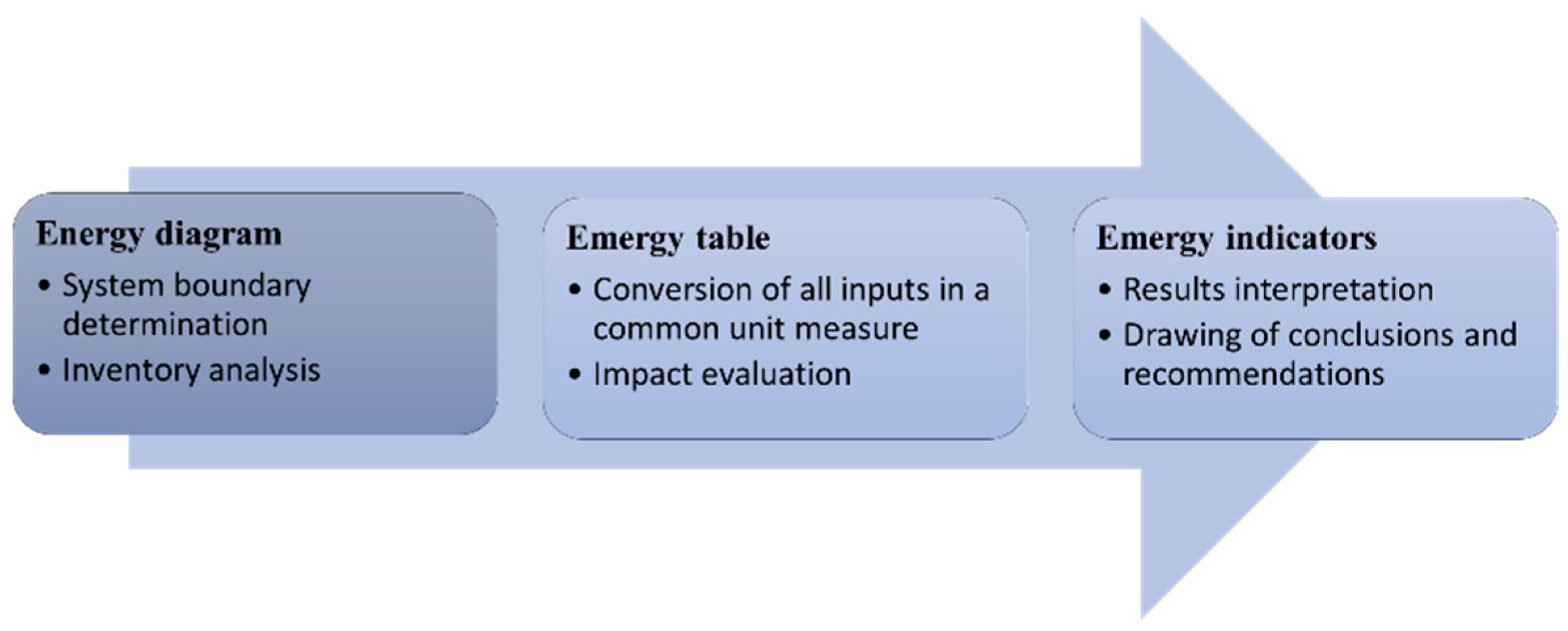
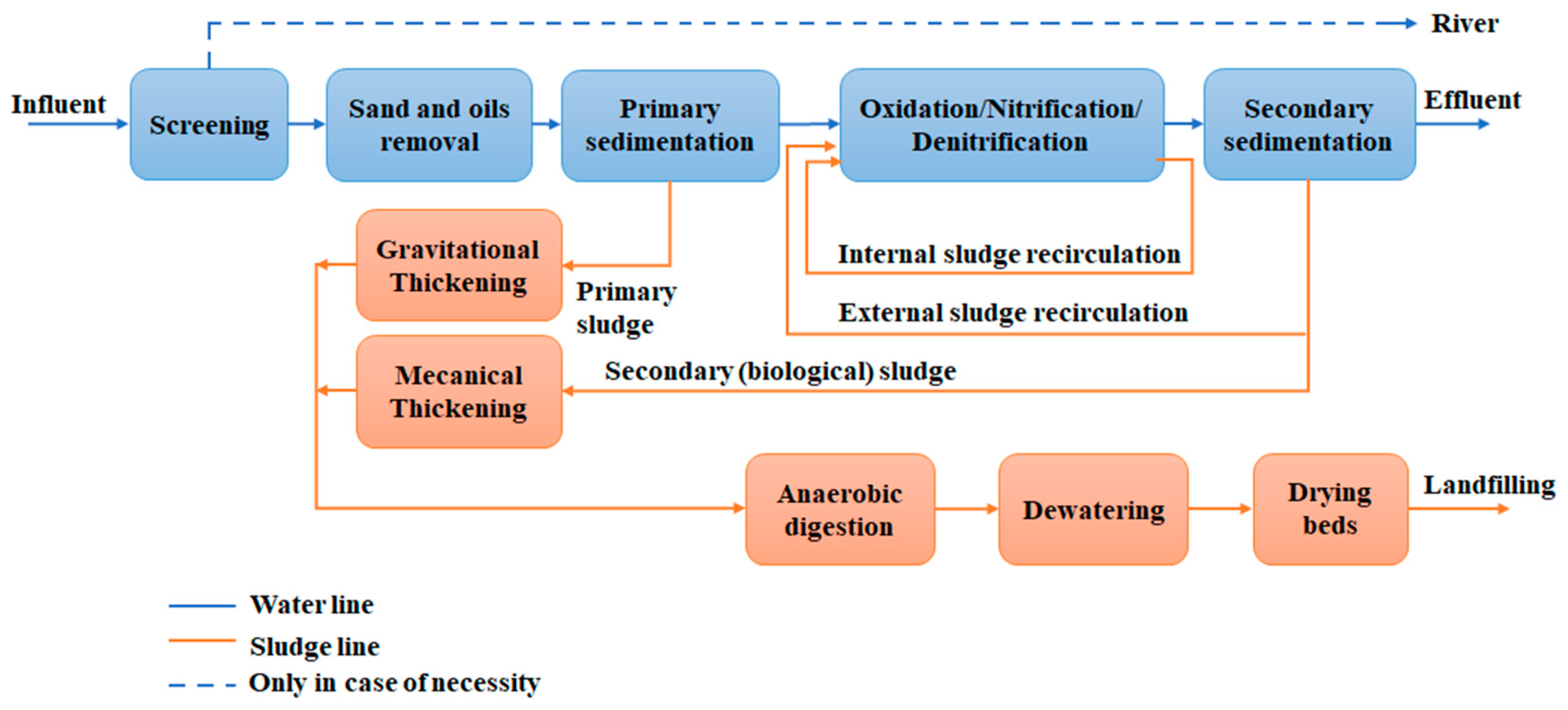
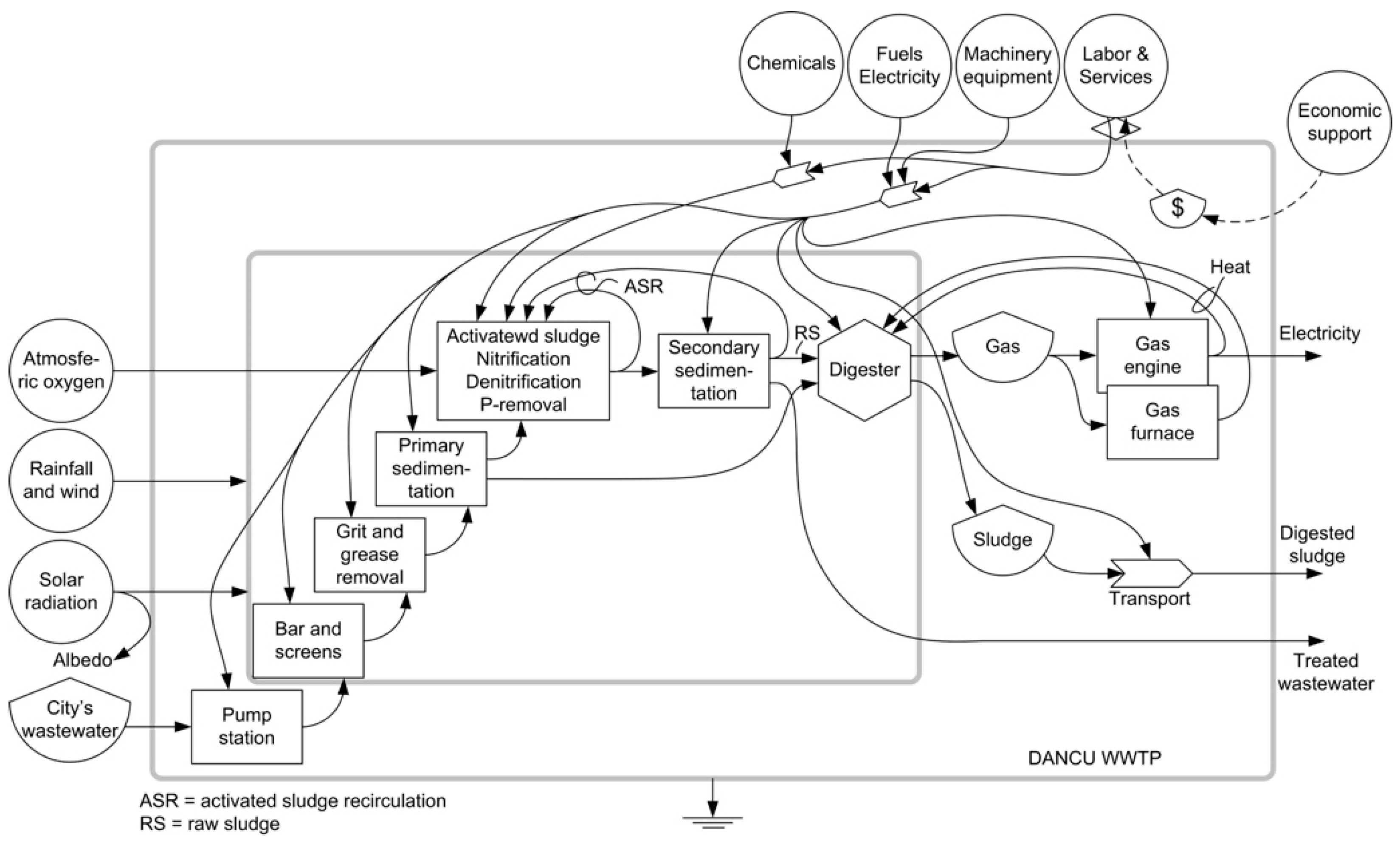
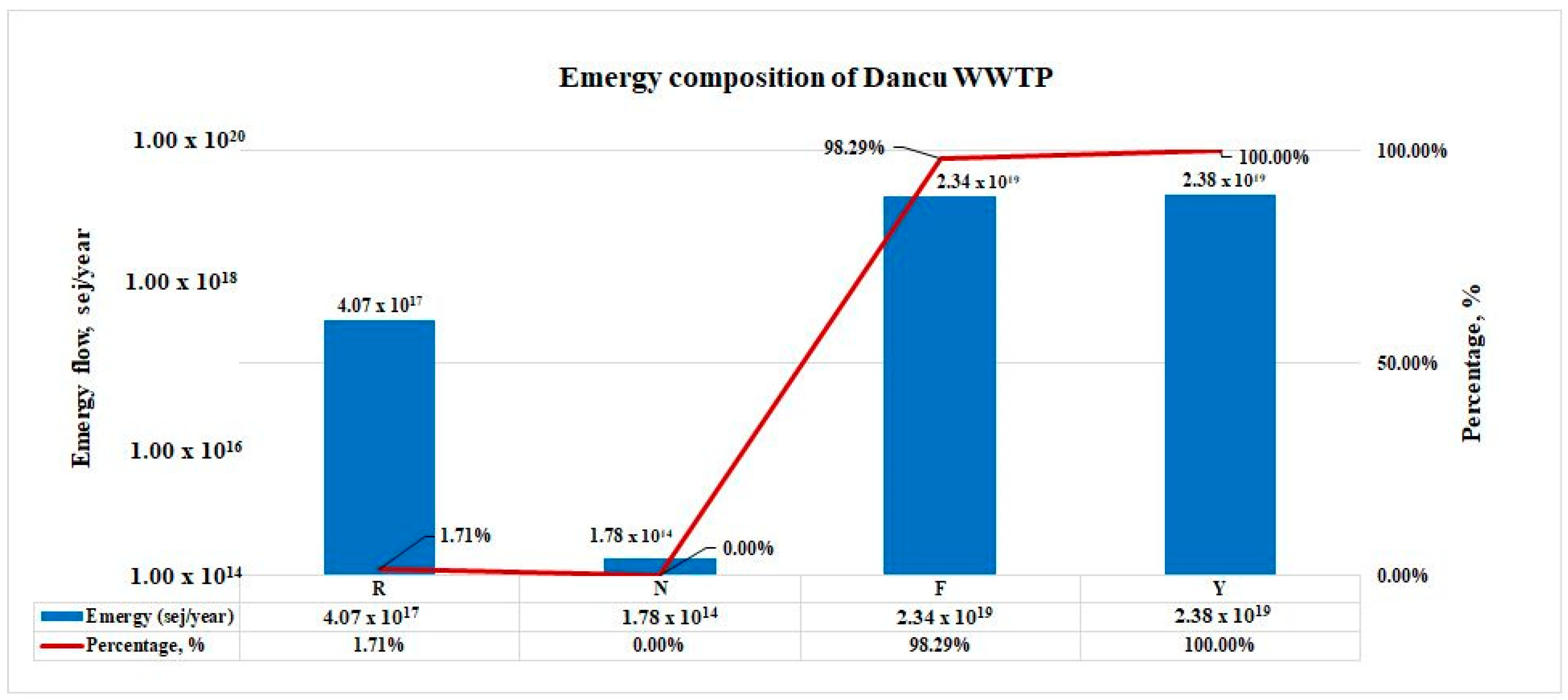
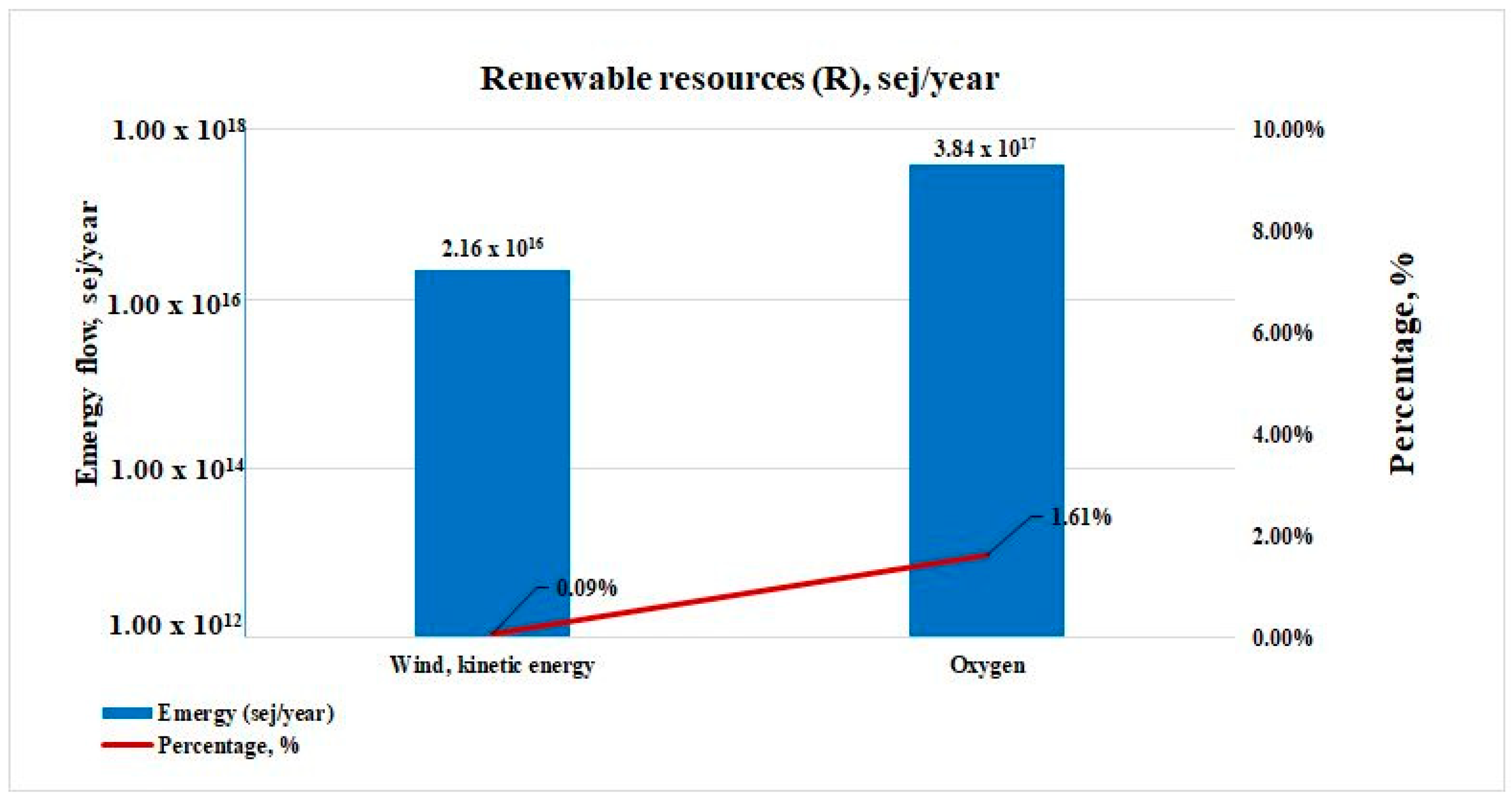
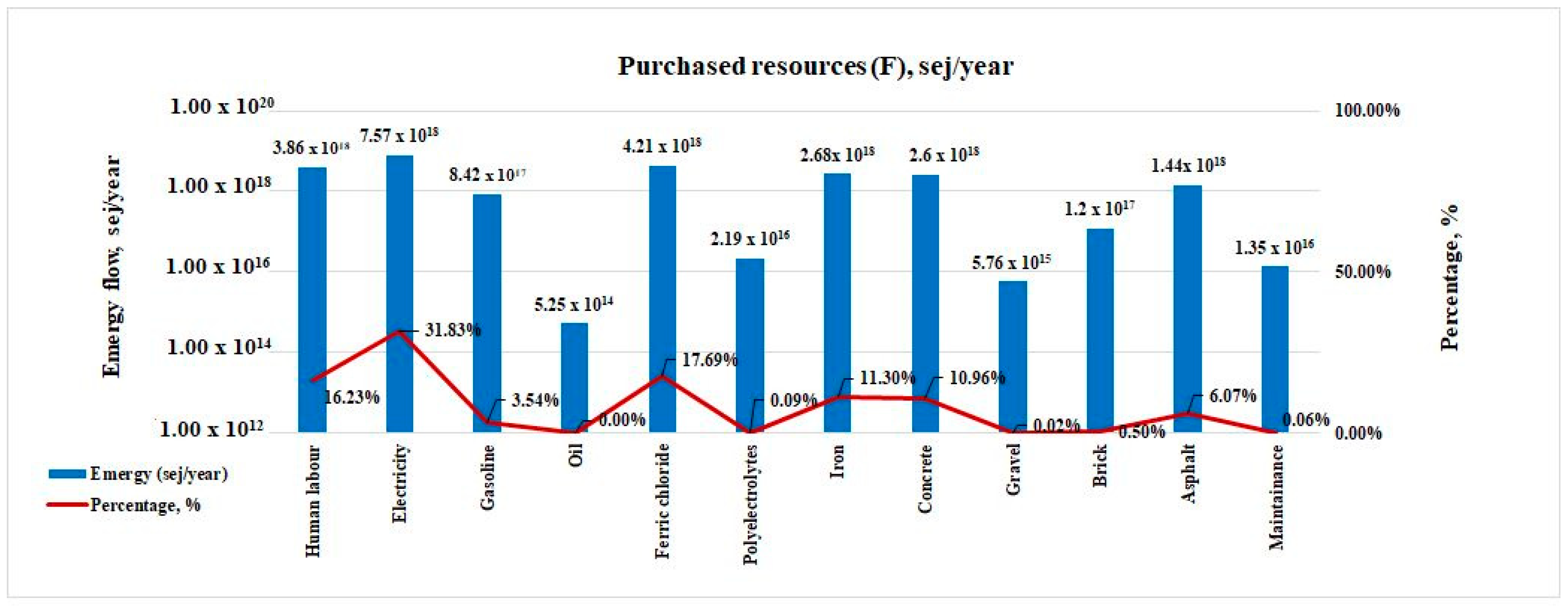
| Refs | Application of EmA | Country |
|---|---|---|
| [35] | Municipal wastewater treatment and generation of electricity by digestion of sewage sludge. | Sweden |
| [36] | Analysis and comparison of the use of environmental resources in three different wastewater treatment systems: conventional MWWTP, MWWTP coupled with constructed wetland; and treatment in a natural wetland. | Sweden |
| [31] | Evaluation of the use of environmental resources for a conventional treatment plant, coupled with a constructed wetland. | Italy |
| [30] | Evaluation of the complete treatment for an MWWTP. | Italy |
| [33] | Improved emergy-based indicators applied to evaluate two alternative scenarios for a sewage treatment system. | China |
| [1] | Analysis of two different wastewater treatment systems commonly used in Brazil, calculating the role of energy and materials consumption and carbon emissions. | Brazil |
| [18] | Comparison of four different wastewater treatment processes from a sustainability point of view. | China |
| [37] | Assessment of the environmental economic value and sustainability of a decentralized sewage treatment plant. | China |
| [32] | Sustainable utilization of biosolids generated in a municipal wastewater treatment plant. | USA |
| [34] | Scenarios for transition from water supply of an overexploited aquifer to wastewater treatment plants that are capable of implementing additional units to achieve drinking water quality. | Mexico |
| [29] | Emergy assessment of a wastewater treatment pond system. | Sweden |
| [19] | Provided a quantification of the total resource use of an urban water system, from raw water extraction for drinking water to wastewater treatment and discharge. | USA |
| [8] | Explored the sustainability of wastewater and sludge management from a systems ecological perspective. | Sweden |
| Method | Life Cycle Assessment (LCA) | Environmental Impact Quantification (EIQ) | Grey Water Footprint (GWF) | Emergy Analysis (EmA) |
|---|---|---|---|---|
| Impact quantification principle | Causality chain (emission, transport, effect, damage) | Individual polluter contribution to river pollution (load) | Virtual water volume needed to dilute pollution to acceptable levels | Holistic evaluation of a process sustainability |
| Impact definition (meaning) | Impact (damage) = Magnitude × dose × exposure | Impact = magnitude (loads) × severity (receiving river status) | Impact = virtual water volume needed to dilute pollutant loads to acceptable levels | Impact = resources, goods, or services consumption, to build and maintain the wastewater treatment system |
| Impact Classification System (reference system) |
|
| River natural water quality (spring section) | Emergy required of the process, to produce 1 Joule of a product or service |
| Data requirements | Emissions to air, water (quality indicators) Waste flows Wastewater flows Electricity use Natural gas consumption Materials use | Wastewater quality indicators Water quality indicators Wastewater Flows | Wastewater quality indicators Water quality indicatorsFlows | Energy flows (sunlight, wind, etc.) Electricity, fuels, and chemicals consumption Production materials Human labor and services Machinery and equipment Water and wastewater flows Financial resources |
| Strong points |
|
|
|
|
| Weak points |
|
|
|
|
| Development status and integration |
|
|
|
|
| Parameter | Value |
|---|---|
| Year of inventory | 2019 |
| Year plant was built | 1968 |
| Number of people served | 386,000 |
| Area of plant | ~14 ha |
| Assumed lifetime of building, tanks, and pipes | 50 years |
| Assumed lifetime of machinery | 20 years |
| Treated wastewater volume | 44,919,743 m3/year |
| Sludge volume | 12,000 m3/day |
| Electricity consumption | 9542.015 MWh/year |
| Wastewater Quality Indicators | Influent Values (mg/L) | Effluent Values (mg/L) | MAC * (mg/L) | RE, % |
|---|---|---|---|---|
| Biochemical oxygen demand, BOD | 139.90 | 9.44 | 25 | 93.25 |
| Chemical oxygen demand, COD | 228.50 | 30.96 | 125 | 86.45 |
| Total suspended solids, TSS | 141.93 | 10.39 | 35 | 96.28 |
| Total Nitrogen, TN | 29.55 | 6.76 | 10 | 77.14 |
| Total Phosphorous, TP | 3.43 | 0.91 | 1 | 73.50 |
| Item | Unit | Basic Data (unit/yr) | UEVs (b) (sej/unit) | Refs. | Emergy (sej/yr) | Percentage % | Unit Ton of Emergy |
|---|---|---|---|---|---|---|---|
| Renewable resources—R | |||||||
| Sunlight (a) | J | 6.62 × 1014 | 1 | [17] | 6.62 × 1014 | 0.00% | 1.47 × 107 |
| Wind, kinetic energy | J | 2.71 × 1013 | 8.00 × 102 | [19] | 2.17 × 1016 | <1% | 4.83 × 108 |
| Rain, chemical energy (a) | J | 3.86 × 1011 | 7.00 × 103 | [19] | 2.70 × 1015 | 0.00% | 6.02 × 107 |
| Rain, potential energy (a) | J | 1.54 × 109 | 2.79 × 104 | [43] | 4.30 × 1013 | 0.00% | 9.57 × 105 |
| Oxygen | g | 5.86 × 109 | 6.56 × 107 | [44] | 3.84 × 1017 | 1.61% | 8.56 × 109 |
| Non-renewable resources—N | |||||||
| Land occupation | m2 | 1.40 × 105 | 1.27 × 109 | [19] | 1.78 × 1014 | 0.00% | 3.96 × 106 |
| Purchased resources—F | |||||||
| Human labor | J | 2.84 × 1011 | 1.36 × 107 | [43] | 3.86 × 1018 | 16.23% | 8.60 × 1010 |
| Electricity | kWh | 9.54 × 106 | 7.94 × 1011 | [17] | 7.58 × 1018 | 31.83% | 1.69 × 1011 |
| Fuels (gasoline) | J | 4.84 × 1012 | 1.74 × 105 | [19] | 8.42 × 1017 | 3.54% | 1.87 × 1010 |
| Fuels (oil) | J | 4.27 × 109 | 1.23 × 105 | [19] | 5.25 × 1014 | 0.00% | 1.17 × 107 |
| Ferric chloride | kg | 864,600 | 4.87 × 1012 | [44] | 4.21 × 1018 | 17.69% | 9.37 × 1010 |
| Polyelectrolyte | kg | 4860 | 4.51 × 1012 | [19] | 2.19 × 1016 | <1% | 4.88 × 108 |
| Iron | kg | 8.76 × 105 | 3.07 × 1012 | [19] | 2.69 × 1018 | 11.30% | 5.99 × 1010 |
| Concrete | kg | 1.35 × 106 | 1.93 × 1012 | [43] | 2.61 × 1018 | 10.96% | 5.81 × 1010 |
| Gravel | kg | 4.06 × 103 | 1.42 × 1012 | [43] | 5.77 × 1015 | <1% | 1.28 × 108 |
| Brick | kg | 4.26 × 104 | 2.82 × 1012 | [43] | 1.20 × 1017 | <1% | 2.67 × 109 |
| Asphalt | kg | 4.14 × 105 | 3.49 × 1012 | [43] | 1.44 × 1018 | 6.07% | 3.22 × 1010 |
| Maintenance | kg | 4.03 × 106 | 3.37 × 109 | [35] | 1.36 × 1015 | <1% | 3.03 × 108 |
| Emergy value of renewable inputs, R | 4.06 × 1017 | 1.71% | 9.06 × 109 | ||||
| Emergy value of non-renewable, N | 1.78 × 1014 | 0.00% | 3.96 × 106 | ||||
| Emergy value of purchased inputs, F | 2.34 × 1019 | 98.29% | 5.21 × 1011 | ||||
| Emergy value used for wastewater treatment, Y | 2.38 × 1019 | 100.00% | 5.30 × 1011 | ||||
| Total emergy, without environmental services | 2.380 × 1019 | ||||||
| Emergy per unit of treated wastewater (transformities calculation) | |||||||
| Emergy per m3 of treated wastewater | sej/m3 | 5.30 × 1011 | |||||
| Emergy per J of treated wastewater | sej/J | 12.4 | |||||
| Emergy per g of treated wastewater | sej/g | 5.30 × 105 | |||||
| 1 | ECEWBOD | 2.31 × 1016 sej/year |
| 2 | ECEWCOD | 7.95 × 1015 sej/year |
| 3 | ECEWTSS | 2.57 × 1016 sej/year |
| 4 | ECEWTN | 4.26 × 1016 sej/year |
| 5 | ECEWTP | 4.9 × 1016 sej/year |
| ECEWmax | 4.9 × 1016 sej/year | |
| Total emergy, considering environmental services to dilute pollutants | 2.385 × 1019 |
| References | Wastewater Treatment Process | WWTP Capacity m3/year | UEVs sej/m3 | Emergy Baseline sej/year |
|---|---|---|---|---|
| This study | Activated sludge + chemical precipitation | 44,919,743 | 5.30 × 1011 | 12.0 × 1024 |
| [43] | Activated sludge | 91,250,000 | 3.40 × 1012 | 12.0 × 1024 |
| [1] | Activated sludge | 504,576 | 1.30 × 1012 | 15.83 × 1024 |
| Year | Wastewater Volume, m3 | UEV, sej/m3 |
|---|---|---|
| 2018 | 40,829,410 | 5.83 × 1011 |
| 2019 | 44,919,743 | 5.30 × 1011 |
| 2020 | 44,929,511 | 5.30 × 1011 |
| 2021 | 43,919,753 | 5.42 × 1011 |
| Emergy Indicators | |||
|---|---|---|---|
| Emergy Yield Ratio—EYR | (N + R + F)/F = Y/F | 1.02 | Emergy efficiency and economic |
| Environment Load Ratio—ELR | (N + F)/R | 57.52 | Environmental loading exerted by the system |
| Emergy Sustainable Index—ESI | EYR/ELR | 0.02 | Sustainability of the system |
| Renewable ratio—%R | R/Y × 100 | 1.71% | Sustainability of the system |
Publisher’s Note: MDPI stays neutral with regard to jurisdictional claims in published maps and institutional affiliations. |
© 2022 by the authors. Licensee MDPI, Basel, Switzerland. This article is an open access article distributed under the terms and conditions of the Creative Commons Attribution (CC BY) license (https://creativecommons.org/licenses/by/4.0/).
Share and Cite
Ciobanu, R.; Teodosiu, C.; Almeida, C.M.V.B.; Agostinho, F.; Giannetti, B.F. Sustainability Analysis of a Municipal Wastewater Treatment Plant through Emergy Evaluation. Sustainability 2022, 14, 6461. https://doi.org/10.3390/su14116461
Ciobanu R, Teodosiu C, Almeida CMVB, Agostinho F, Giannetti BF. Sustainability Analysis of a Municipal Wastewater Treatment Plant through Emergy Evaluation. Sustainability. 2022; 14(11):6461. https://doi.org/10.3390/su14116461
Chicago/Turabian StyleCiobanu, Ramona, Carmen Teodosiu, Cecilia M. V. B. Almeida, Feni Agostinho, and Biagio Fernando Giannetti. 2022. "Sustainability Analysis of a Municipal Wastewater Treatment Plant through Emergy Evaluation" Sustainability 14, no. 11: 6461. https://doi.org/10.3390/su14116461
APA StyleCiobanu, R., Teodosiu, C., Almeida, C. M. V. B., Agostinho, F., & Giannetti, B. F. (2022). Sustainability Analysis of a Municipal Wastewater Treatment Plant through Emergy Evaluation. Sustainability, 14(11), 6461. https://doi.org/10.3390/su14116461








